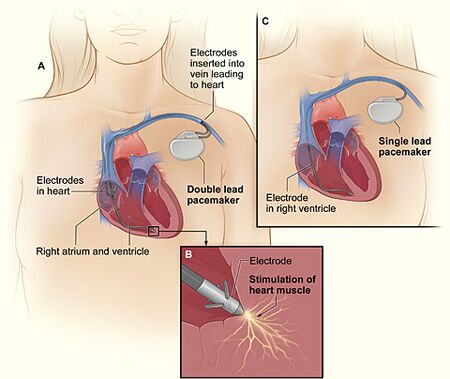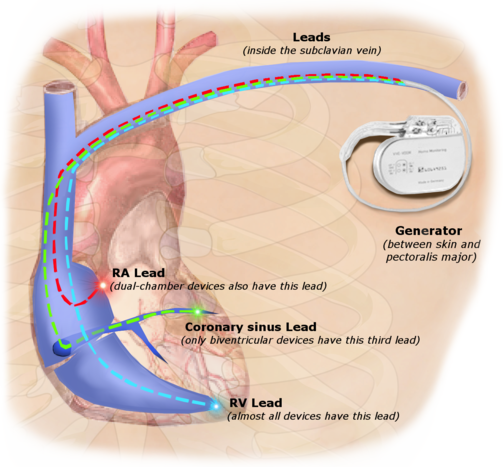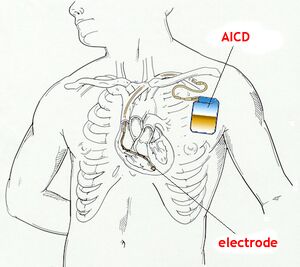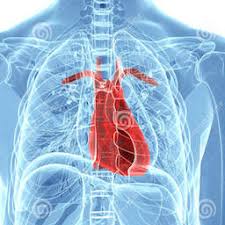Cardiac Implantable Electronic Devices (CIEDs): Difference between revisions
Justin Bryan (talk | contribs) No edit summary |
Justin Bryan (talk | contribs) No edit summary |
||
| Line 18: | Line 18: | ||
== Why Cardiac Implantable Electronic Devices are Used == | == Why Cardiac Implantable Electronic Devices are Used == | ||
'''Pacemakers:''' Used primarily to control the rhythm or pace of a beating heart, they are generally indicated for cases where the concern is symptomatic bradycardia due to medication, heart block, heart failure, or abnormal cardiac rhythms. Pacemakers help control the inherent beating of the heart, or in some cases, may be solely responsible for generating and maintaining rhythm in a heart that does not produce any inherent beating.<ref name=":1" /> | '''Pacemakers:''' Used primarily to control the rhythm or pace of a beating heart, they are generally indicated for cases where the concern is symptomatic [[bradycardia]] due to medication, heart block, [[Heart Failure|heart failure]], or abnormal cardiac rhythms/[[Heart Arrhythmias|arrhythmia]]. Pacemakers help control the inherent beating of the heart, or in some cases, may be solely responsible for generating and maintaining rhythm in a heart that does not produce any inherent beating.<ref name=":1" /> | ||
There are many different variations of pacemakers, each of which can be used to address a specific condition or symptom. Pacing requirements can fall on a spectrum from entirely dependent, where the heart does not produce any beats itself, to intermittent pacing, where the | There are many different variations of pacemakers, each of which can be used to address a specific condition or symptom. Pacing requirements can fall on a spectrum from entirely dependent pacing, where the heart does not produce any beats itself, to intermittent pacing, where the CIED senses rhythm changes or deficiencies and "assists" only when needed.<ref name=":1" /> | ||
Types of therapies pacemakers can provide include those that address bradycardia originating in either the atria or ventricle, this is one of the more basic forms of pacing. Another therapy, cardiac resynchronization therapy (CRT), is use in the treatment of heart failure. CRT utilizes a biventricular pacemaker to address a common situation seen with HF | Types of therapies pacemakers can provide include those that address [[bradycardia]] originating in either the atria or ventricle, this is one of the more basic forms of pacing. Another therapy, cardiac resynchronization therapy (CRT), is use in the treatment of [[Heart Failure|heart failure]]. CRT utilizes a biventricular pacemaker to address a common situation seen in patients with HF where the two ventricles do not pump in a normal manner (i.e. ventricular desynchrony). When this happens, less blood is pumped by the heart. A biventricular pacemaker paces both ventricles at the same time, increasing the amount of [[Blood Physiology|blood]] pumped by the heart. Additional therapies include anti-tachycardia pacing (ATP), which is a treatment used for those with [[Heart Arrhythmias|arrhythmia]] that increase the rate that a chamber beats (i.e. ventricular tachycardia or [[Atrial Fibrillation|atrial fibrillation]]). These pacemakers may disrupt the arrhythmia by inducing the heart to be temporarily beat at a rate greater than that created by the arrhythmia. Pacemakers may also be set up to monitor for certain rhythm changes, such as missed beats, and provide pacing as appropriate.<ref name=":1" /><ref name=":2" /> | ||
'''Defibrillators:''' These devices are utilized in patients | '''Defibrillators:''' These devices are utilized in patients diagnosed with life threatening arrhythmia or other conditions that may result in sudden cardiac death. This includes such situations as reduced ventricular function or ventricular arrhythmia such as ventricular tachycardia. Defibrillators may also be used in those with a history of [[Cardiac Arrest|cardiac arrest]]. One to three leads may be utilized to monitor different chambers (similar to pacemakers), or monitoring may be performed directly from the pulse generator. When a life threatening condition is sensed, the defibrillator will provide an electric shock intended to restore the hearts normal rhythm. Automatic Implantable Cardioverter Defibrillators (AICD/ICD) are a type of defibrillator device.<ref name=":1" /> | ||
'''Loop Recorders:''' These devices are purely monitoring devices and are not utilized to provide any therapy. They are used as part of the diagnostic process in cases where the cause of a specific cardiac event is unable to be determined | '''Loop Recorders:''' These devices are purely monitoring devices and are not utilized to provide any therapy. They are used as part of the diagnostic process in cases where the cause of a specific cardiac event is unable to be determined. Loop recorders can then provide information regarding heart rhythm that can be used to provide insight on potential underlying causes of such events. Common events that may warrant a loop recorder include syncope or palpitations that occur without an obvious cause.<ref name=":1" /> | ||
== Major components == | == Major components == | ||
There are many variations of Cardiac | There are many variations of Cardiac Implantable Electronic Devices depending on their application and manufacturer. Generally though, the two main components of these devices are a pulse generator and leads (except in leadless pacemakers). | ||
# A pulse generator: A small metal | # A pulse generator: A small metal container or box commonly implanted in an area of the chest wall just below the clavicle. The generator contains a battery used to produce the electrical current that controls rhythm, as well as power the small computer chip that interprets inherent rhythms and controls the activation and production of impulses used for various therapies.<ref name=":2">John Hopkins [https://www.hopkinsmedicine.org/health/treatment-tests-and-therapies/pacemaker-insertion Pacemake]r Available from:https://www.hopkinsmedicine.org/health/treatment-tests-and-therapies/pacemaker-insertion (accessed 30.4.2021)</ref><ref name=":4">Lak HM, Goyal A. Pacemaker Types and Selection. StatPearls [Internet]. Treasure Island (FL): StatPearls Publishing; 2023. Available from: <nowiki>https://www.ncbi.nlm.nih.gov/books/NBK556011/</nowiki></ref> | ||
# The lead(s) are wires used for both sensing of inherent rhythm and conduction of impulses from the pulse generator to the heart. The lead(s) of most modern pacemakers are routed transvenously, | # The lead(s) are wires used for both sensing of inherent rhythm and conduction of impulses from the pulse generator to the heart. The lead(s) of most modern pacemakers are routed transvenously, traveling typically through the subclavian vein from a point near the pulse generator and ending up inside the heart chambers. The tip of each lead is embedded in the tissue of the corresponding chamber that it controls or monitors.<ref name=":2" /><ref name=":4" /> | ||
== Pacemakers == | == Pacemakers == | ||
[[File:Pakemaker leads.png|right|frameless|503x503px]] | [[File:Pakemaker leads.png|right|frameless|503x503px]] | ||
Pacemakers are often categorized depending on the number of electrodes and location of pacing: | |||
* Single chamber | * Single chamber (single lead) pacemakers utilize one lead that terminates in either the right atria or right ventricle, providing sensing and/or pacing to that chamber only.<ref name=":1" /> | ||
* Dual | * Dual chamber (dual lead) pacemakers require two leads traveling to two separate chambers of the heart. Typically this is for sensing/pacing of the right atrium and right ventricle, but in the case of CRT, leads would go to both ventricles instead. In these cases, sensing and pacing is separate for each chamber, and can also be set up to both increase and decrease the rate depending on the rhythm sensed.<ref>Goldberger AL, Goldberger ZD, Shvilkin A. [https://www.sciencedirect.com/topics/nursing-and-health-professions/dual-chamber-pacemaker Clinical electrocardiography: a simplified approach e-book]. Elsevier Health Sciences; 2017 Mar 19.Available from: https://www.sciencedirect.com/topics/nursing-and-health-professions/dual-chamber-pacemaker<nowiki/>(accessed 30.4.2021)</ref> | ||
* | * Three lead pacemakers can sense and/or pace three chambers, typically the right atria, and both ventricles.<ref name=":1" /> | ||
* Leadless pacemakers are used to pace a single chamber without the need for leads or a pulse generator outside the heart. Leadless devices are implanted directly into the tissue inside of the target chamber. Currently these devices are generally approved only for single chamber pacing to address conditions such as bradycardia.<ref>Cleveland clinic LLPM Available :https://my.clevelandclinic.org/health/treatments/17166-pacemakers-leadless-pacemaker (accessed 30.4.2021)</ref> | |||
== Automatic Implantable Cardioverter Defibrillators (AICD) == | == Automatic Implantable Cardioverter Defibrillators (AICD) == | ||
| Line 50: | Line 50: | ||
If the heart's rate is slower than the programmed limit, an electrical impulse is sent through the lead(s) to the electrode, causing the heart to beat at a faster rate. | If the heart's rate is slower than the programmed limit, an electrical impulse is sent through the lead(s) to the electrode, causing the heart to beat at a faster rate. | ||
When the heart beats at a rate faster than the programmed limit, the pacemaker generally monitors the heart rate and will not typically pace. In instances where | When the heart beats at a rate faster than the programmed limit, the pacemaker generally monitors the heart rate and will not typically pace. In instances where an anti-tachycardia device is used, a rate above the programmed limit will trigger a response such as a temporary higher pacing rate (higher than the sensed rate) which can disrupt the abnormality and return the heart to a more normal pace. Modern pacemakers are programmed to work on demand only, so they do not compete with natural heartbeats. Generally, no electrical impulses will be sent to the heart unless the [[Pulse rate|heart's natural rate]] falls below the pacemaker's lower limit, or the device is set up specifically to address tachycardia events.<ref name=":1" /><ref name=":2" /> | ||
== Landmark Innovations == | == Landmark Innovations == | ||
In 2020, news was released that cardiologists working for Monash Health reached a breakthrough in the treatment of [[cardiomyopathies]], | In 2020, news was released that cardiologists working for Monash Health reached a breakthrough in the treatment of [[cardiomyopathies]], a group of conditions that reduce the heart's ability to function and can often result in heart failure. This breakthrough was the the implementation of a leadless pacemaker, the first of its kind, which utilized two devices to help resynchronise the pumping action of the heart and improve overall function. Where traditional pacemakers devices utilize leads to deliver pulses from a generator located away from the heart, these leadless devices are afixed directly to the myocardial tissue within the ventricles. Both devices, an ultrasonically activated left ventricular pacer the size of a grain of rice, and a slightly larger right ventricular pacer, were delivered tranvenously via a small access point. The pacing used by the devices was also innovative, known as physiologic pacing, whereby the healthy rhythm produced by the right atria is sensed by the system and used as the driver to resynchronise the beating of the ventricles.<ref>Monash Health [https://monashhealth.org/latest-news/2020/10/15/monash-health-implants-world-first-leadless-pacemaker-treatment-for-heart-failure/ Monash Health implants world-first leadless pacemaker treatment for heart failure]. Available: https://monashhealth.org/latest-news/2020/10/15/monash-health-implants-world-first-leadless-pacemaker-treatment-for-heart-failure/ (accessed 30.4.2021)</ref>[[File:Heart location.jpg|right|frameless]]In 2019, a study published in the Journal of Physiology described a new treatment for heart failure known as a bionic pacemaker. This bionic pacemaker has the ability to pace the heart at a more natural, variable, rhythm that mimics the normal variation in heart rate that occurs with natural processes of the body. One such variation is respiratory sinus arrhythmia, a normal process whereby the heart rate actually increases and then decreases with the normal inhale and exhale of breathing, respectfully. Traditional pacemakers deliver a rhythm at a constant interval, meaning that under normal resting conditions there is no change in rate with respect to physiologic processes that would normally impact rate.<ref name=":3">News Medical New type of bionic pacemaker Available:https://www.news-medical.net/news/20191114/New-type-of-bionic-pacemaker.aspx (accessed 30.4.2021)</ref> | ||
== Physiotherapy == | == Physiotherapy == | ||
Revision as of 19:48, 27 March 2023
Original Editor - Lucinda hampton
Top Contributors - Lucinda hampton, Justin Bryan and Kim Jackson
Introduction[edit | edit source]
Cardiac implantable electronic devices (CIED), or Cardiac Rhythm Management Devices (CRMD), are a very common medical device. The number of implanted cardiovascular devices has dramatically increased in recent years. Many people utilize "Pacemaker" as a general term for these devices, but in actuality, a pacemaker is a specific type of CIED. Additionally, there is a variety of other devices that fall under this general umbrella.[1]
There are several major types of CEIDs:
- Pacemakers
- Defibrillators - Including automatic implantable cardioverter-defibrillators (AICD/ICD) (may be co-implanted as an ICD-pacemaker combination)
- Loop Recorders
Leadless cardiac pacemakers are a recently introduced type of CEID. These pacemakers are self-contained right ventricular, single-chamber, pacemakers.[2] Outcomes have generally been positive for cases where leadless pacemakers have been utilized and initially the safety and efficacy appears promising. For this reason, their use has been on the rise, resulting in a shift that now marks a new era of cardiac pacing. [3]
Why Cardiac Implantable Electronic Devices are Used[edit | edit source]
Pacemakers: Used primarily to control the rhythm or pace of a beating heart, they are generally indicated for cases where the concern is symptomatic bradycardia due to medication, heart block, heart failure, or abnormal cardiac rhythms/arrhythmia. Pacemakers help control the inherent beating of the heart, or in some cases, may be solely responsible for generating and maintaining rhythm in a heart that does not produce any inherent beating.[1]
There are many different variations of pacemakers, each of which can be used to address a specific condition or symptom. Pacing requirements can fall on a spectrum from entirely dependent pacing, where the heart does not produce any beats itself, to intermittent pacing, where the CIED senses rhythm changes or deficiencies and "assists" only when needed.[1]
Types of therapies pacemakers can provide include those that address bradycardia originating in either the atria or ventricle, this is one of the more basic forms of pacing. Another therapy, cardiac resynchronization therapy (CRT), is use in the treatment of heart failure. CRT utilizes a biventricular pacemaker to address a common situation seen in patients with HF where the two ventricles do not pump in a normal manner (i.e. ventricular desynchrony). When this happens, less blood is pumped by the heart. A biventricular pacemaker paces both ventricles at the same time, increasing the amount of blood pumped by the heart. Additional therapies include anti-tachycardia pacing (ATP), which is a treatment used for those with arrhythmia that increase the rate that a chamber beats (i.e. ventricular tachycardia or atrial fibrillation). These pacemakers may disrupt the arrhythmia by inducing the heart to be temporarily beat at a rate greater than that created by the arrhythmia. Pacemakers may also be set up to monitor for certain rhythm changes, such as missed beats, and provide pacing as appropriate.[1][4]
Defibrillators: These devices are utilized in patients diagnosed with life threatening arrhythmia or other conditions that may result in sudden cardiac death. This includes such situations as reduced ventricular function or ventricular arrhythmia such as ventricular tachycardia. Defibrillators may also be used in those with a history of cardiac arrest. One to three leads may be utilized to monitor different chambers (similar to pacemakers), or monitoring may be performed directly from the pulse generator. When a life threatening condition is sensed, the defibrillator will provide an electric shock intended to restore the hearts normal rhythm. Automatic Implantable Cardioverter Defibrillators (AICD/ICD) are a type of defibrillator device.[1]
Loop Recorders: These devices are purely monitoring devices and are not utilized to provide any therapy. They are used as part of the diagnostic process in cases where the cause of a specific cardiac event is unable to be determined. Loop recorders can then provide information regarding heart rhythm that can be used to provide insight on potential underlying causes of such events. Common events that may warrant a loop recorder include syncope or palpitations that occur without an obvious cause.[1]
Major components[edit | edit source]
There are many variations of Cardiac Implantable Electronic Devices depending on their application and manufacturer. Generally though, the two main components of these devices are a pulse generator and leads (except in leadless pacemakers).
- A pulse generator: A small metal container or box commonly implanted in an area of the chest wall just below the clavicle. The generator contains a battery used to produce the electrical current that controls rhythm, as well as power the small computer chip that interprets inherent rhythms and controls the activation and production of impulses used for various therapies.[4][5]
- The lead(s) are wires used for both sensing of inherent rhythm and conduction of impulses from the pulse generator to the heart. The lead(s) of most modern pacemakers are routed transvenously, traveling typically through the subclavian vein from a point near the pulse generator and ending up inside the heart chambers. The tip of each lead is embedded in the tissue of the corresponding chamber that it controls or monitors.[4][5]
Pacemakers[edit | edit source]
Pacemakers are often categorized depending on the number of electrodes and location of pacing:
- Single chamber (single lead) pacemakers utilize one lead that terminates in either the right atria or right ventricle, providing sensing and/or pacing to that chamber only.[1]
- Dual chamber (dual lead) pacemakers require two leads traveling to two separate chambers of the heart. Typically this is for sensing/pacing of the right atrium and right ventricle, but in the case of CRT, leads would go to both ventricles instead. In these cases, sensing and pacing is separate for each chamber, and can also be set up to both increase and decrease the rate depending on the rhythm sensed.[6]
- Three lead pacemakers can sense and/or pace three chambers, typically the right atria, and both ventricles.[1]
- Leadless pacemakers are used to pace a single chamber without the need for leads or a pulse generator outside the heart. Leadless devices are implanted directly into the tissue inside of the target chamber. Currently these devices are generally approved only for single chamber pacing to address conditions such as bradycardia.[7]
Automatic Implantable Cardioverter Defibrillators (AICD)[edit | edit source]
AICDs are common cardiac devices designed for both patient monitoring and therapy in cases of ventricular tachycardia or fibrillation. AICDs consist of various combinations of sensing and shocking electrodes/leads. They are frequently combined with a pacemaker, treating both the patient’s established arrhythmia and also acting as a fail-safe system should ventricular fibrillation or ventricular tachycardia occur.[1]
Activation of Pacemakers and AICDs[edit | edit source]
If the heart's rate is slower than the programmed limit, an electrical impulse is sent through the lead(s) to the electrode, causing the heart to beat at a faster rate.
When the heart beats at a rate faster than the programmed limit, the pacemaker generally monitors the heart rate and will not typically pace. In instances where an anti-tachycardia device is used, a rate above the programmed limit will trigger a response such as a temporary higher pacing rate (higher than the sensed rate) which can disrupt the abnormality and return the heart to a more normal pace. Modern pacemakers are programmed to work on demand only, so they do not compete with natural heartbeats. Generally, no electrical impulses will be sent to the heart unless the heart's natural rate falls below the pacemaker's lower limit, or the device is set up specifically to address tachycardia events.[1][4]
Landmark Innovations[edit | edit source]
In 2020, news was released that cardiologists working for Monash Health reached a breakthrough in the treatment of cardiomyopathies, a group of conditions that reduce the heart's ability to function and can often result in heart failure. This breakthrough was the the implementation of a leadless pacemaker, the first of its kind, which utilized two devices to help resynchronise the pumping action of the heart and improve overall function. Where traditional pacemakers devices utilize leads to deliver pulses from a generator located away from the heart, these leadless devices are afixed directly to the myocardial tissue within the ventricles. Both devices, an ultrasonically activated left ventricular pacer the size of a grain of rice, and a slightly larger right ventricular pacer, were delivered tranvenously via a small access point. The pacing used by the devices was also innovative, known as physiologic pacing, whereby the healthy rhythm produced by the right atria is sensed by the system and used as the driver to resynchronise the beating of the ventricles.[8]
In 2019, a study published in the Journal of Physiology described a new treatment for heart failure known as a bionic pacemaker. This bionic pacemaker has the ability to pace the heart at a more natural, variable, rhythm that mimics the normal variation in heart rate that occurs with natural processes of the body. One such variation is respiratory sinus arrhythmia, a normal process whereby the heart rate actually increases and then decreases with the normal inhale and exhale of breathing, respectfully. Traditional pacemakers deliver a rhythm at a constant interval, meaning that under normal resting conditions there is no change in rate with respect to physiologic processes that would normally impact rate.[9]
Physiotherapy[edit | edit source]
There are no specific international policies regarding the administration of physiotherapy modalities in cardiac rhythm device patients and, thus, there are no specific guidelines to be implemented at the local level. Review of the literature and of recommendations from CRD manufacturers suggests that TENS, Diathermy, and Interferential Electrical Current Therapy are best avoided in patients with CRDs[10].
Use of upper limbs For 6 to 8 weeks (with device with leads):
• Avoid upper arm movement on the side of your pacemaker such as reaching high, raking, hanging things and swinging a golf club. • Do shoulder rolls daily on the side of the pacemaker to prevent shoulder stiffness. • You can have sex when you feel comfortable. • Ask your doctor when you can drive. • Do not do any heavy lifting. This means do not lift anything over kilograms or 10 pounds such as a bag of groceries, small suitcase or small child.
A patient's lifestyle is usually not modified to any great degree after the insertion of a pacemaker. There are a few activities that are unwise such as full contact sports and activities that involve intense magnetic fields (should be informed from treating Cardiologist)
- eg large and powerful magnets (MRI) affect pacemakers; do not use beds that vibrate; Large motors: the power from motors such as chain saws, cars, tractors, lawnmowers and recreational vehicles may confuse a pacemaker. If this happens, you will feel dizzy. This is related to how close you are. You need to be 1 foot or 30 centimetres from a working motor.[11]
Final Ending[edit | edit source]
A British charity wants to remove pacemakers from people who have died in the UK and send the devices to developing countries for re-use. Pace4Life says thousands of the life-saving devices, which cost thousands of pounds, are typically thrown away or buried with patients each year in the UK[12].
- Pacemaker reuse is feasible and safe and is a viable option for patients with bradyarrhythmias. Other than the expected lower battery life, reuse of pacemaker generators is noninferior to the use of new devices[13].
References[edit | edit source]
- ↑ 1.0 1.1 1.2 1.3 1.4 1.5 1.6 1.7 1.8 1.9 Stevenson I, Voskoboinik A. Cardiac rhythm management devices. Australian Journal of General Practice 2018; 47(5): n.p. Availible from:https://www1.racgp.org.au/ajgp/2018/may/cardiac-rhythm-management-devices
- ↑ Radswiki T, Chieng R, Yap J, et al. Cardiac conduction devices [Internet]. Radiopaedia. 2022 [accessed 29.4.2021]. Availible from: https://doi.org/10.53347/rID-12188
- ↑ Curnis A, Salghetti F, Cerini M, Fabbricatore D, Ghizzoni G, Arrigoni L, Generati G, Arabia G, Maiolo V, Aboelhassan M, Bontempi L. Leadless pacemaker: State of the art and incoming developments to broaden indications. Pacing and Clinical Electrophysiology. 2020 Oct 22.Available from:https://onlinelibrary.wiley.com/doi/10.1111/pace.14097 (accessed 29.4.2021)
- ↑ 4.0 4.1 4.2 4.3 John Hopkins Pacemaker Available from:https://www.hopkinsmedicine.org/health/treatment-tests-and-therapies/pacemaker-insertion (accessed 30.4.2021)
- ↑ 5.0 5.1 Lak HM, Goyal A. Pacemaker Types and Selection. StatPearls [Internet]. Treasure Island (FL): StatPearls Publishing; 2023. Available from: https://www.ncbi.nlm.nih.gov/books/NBK556011/
- ↑ Goldberger AL, Goldberger ZD, Shvilkin A. Clinical electrocardiography: a simplified approach e-book. Elsevier Health Sciences; 2017 Mar 19.Available from: https://www.sciencedirect.com/topics/nursing-and-health-professions/dual-chamber-pacemaker(accessed 30.4.2021)
- ↑ Cleveland clinic LLPM Available :https://my.clevelandclinic.org/health/treatments/17166-pacemakers-leadless-pacemaker (accessed 30.4.2021)
- ↑ Monash Health Monash Health implants world-first leadless pacemaker treatment for heart failure. Available: https://monashhealth.org/latest-news/2020/10/15/monash-health-implants-world-first-leadless-pacemaker-treatment-for-heart-failure/ (accessed 30.4.2021)
- ↑ News Medical New type of bionic pacemaker Available:https://www.news-medical.net/news/20191114/New-type-of-bionic-pacemaker.aspx (accessed 30.4.2021)
- ↑ Digby GC, Daubney ME, Baggs J, Campbell D, Simpson CS, Redfearn DP, Brennan FJ, Abdollah H, Baranchuk A. Physiotherapy and cardiac rhythm devices: a review of the current scope of practice. Europace. 2009 Jul 1;11(7):850-9.Available from:https://academic.oup.com/europace/article/11/7/850/498953 (accessed 30.4.2021)
- ↑ St Joes You and your pacemakerAvailable from:https://www.stjoes.ca/patients-visitors/patient-education/p-t/PacemakerSJH-trh%20(2).pdf (accessed 30.4.2021)
- ↑ Mazumdar T. British Charity Calls for Reuse of Pacemakers Abroad. BBB News Health. 2013.Available: https://www.bbc.com/news/health-24828244(accessed 30.4.2021)
- ↑ Nava S, Morales JL, Márquez MF, Barrera F, Gómez J, Colín L, Brugada J, Iturralde P. Reuse of pacemakers: comparison of short and long-term performance. Circulation. 2013 Mar 19;127(11):1177-83.Available:https://www.ahajournals.org/doi/full/10.1161/CIRCULATIONAHA.113.001584 (accessed 30.4.2021)












